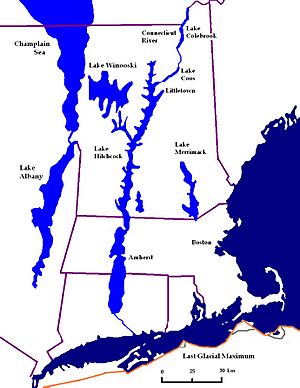Lake Albany facts for kids
Glacial Lake Albany was a huge lake that existed a very long time ago in North America. It formed during the end of the last Ice Age, called the Wisconsinan glaciation. This giant lake was around between 15,000 and 12,600 years ago.
It was created when a huge glacier started to melt. The melted ice, along with water from rivers like the Mohawk, got trapped. An ice dam blocked the water in the Hudson Valley, forming this massive lake. Scientists have studied old plant and animal remains from the lake's bottom. Using a method called carbon dating, they found these materials are about 11,700 years old. Lake Albany stretched about 160 miles (257 km) from what is now Newburgh to Glens Falls in New York.
Contents
How Glacial Lake Albany Formed
This ancient lake was a type of proglacial lake. This means it formed right in front of a huge glacier as it melted. The glacier acted like a giant wall, holding back the water. The Hudson Valley became a huge basin where all this water collected.
The Role of Melting Ice
Imagine a giant ice sheet slowly shrinking. As it melted, vast amounts of water flowed away from it. This water, combined with rivers, filled up the low-lying areas. The ice itself blocked the natural flow of water towards the ocean.
The Ice Dam Effect
The glacier created a natural "dam" of ice. This dam stopped the water from draining away. So, the water kept building up behind the ice, forming the large Glacial Lake Albany. It was a temporary lake, only existing while the glacier was still present.
The Lake's Disappearance
Glacial Lake Albany eventually drained away about 10,500 years ago. This happened because of something called post-glacial rebound. This is when the land slowly rises after the heavy weight of a glacier is removed.
Land Rising After the Ice
When the glacier melted, its enormous weight was lifted from the land. Slowly, over thousands of years, the land began to spring back up. This rising land changed the shape of the Hudson River valley. It allowed the trapped water to finally flow out.
What the Drained Lake Left Behind
When the lake drained, it left behind a lot of interesting things. It exposed sandy and gravelly areas called glaciolacustrine deposits. These were basically the sediments that had settled at the bottom of the lake. A wide, flat area just west of Schenectady was uncovered. This is where the Mohawk River used to flow into the lake.
Sands and Soils
The land that was once the lakebed now has unique topsoil. It includes dune and deltaic sands. These sands often have layers, or "lenses," of silty sand, silt, and clay. This type of soil is what you find under the Albany Pine Bush today.
Layers Beneath the Surface
Underneath these sandy surface deposits, you'll find deeper layers. There are lake-bottom silt and clay. Below that, you'll find till, which is a mix of rock and sediment left by the glacier. Finally, beneath everything, is the solid shale bedrock.
New Creeks Formed
As the lake drained, the flowing water carved out new paths. These small streams, called rills, created several creeks in the town of Colonie, New York. These include Patroon Creek, Sand Creek, Lisha Kill, Shaker Creek, Delphus Kill, and the Salt Kill.


